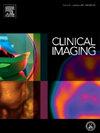Differential epididymal enlargement and identification of the mediastinum testes: New proposed sonographic checklist in the acute assessment of pediatric testicular torsion
IF 1.5
4区 医学
Q3 RADIOLOGY, NUCLEAR MEDICINE & MEDICAL IMAGING
引用次数: 0
Abstract
Background
Testicular torsion is a surgical emergency. We have observed that mass-like epididymal enlargement and morphologic changes to the testicular parenchyma differentially represent testes that are viable versus non-viable at the time of scrotal exploration.
Objective
The purpose of this study is to assess sonographic findings that may help predict the viability of torsed testes at the time of scrotal exploration.
Methods
We retrospectively reviewed 128 scrotal ultrasound exams of surgically confirmed testicular torsions (88 salvageable, 40 non-salvageable) from July 2022 to July 2023 (mean age 13.1 years, range: 1–19 years). We assessed the visibility of the mediastinum testis, the ratio between affected and non-affected testes of the maximal cross-sectional area of the epididymis on a transverse plane, the ratio between affected and non-affected testes of the testicular volume, and subjective evidence of mass-like epididymal enlargement.
Results
Patients with global epididymal enlargement and those with a non-visible mediastinum testis were found to have a statistically higher likelihood of non-salvageable testes (p = 0.0123 and p = 0.0208, respectively). Additionally, a significant association was observed between testicular volume symmetry and the viability of torsed testes (p = 0.0013). Notably, when the volume of the torsed testis exceeded that of the normal contralateral testis by 40 %, it was significantly associated with a non-salvageable outcome (p = 0.0132).
Conclusion
Sonographically visible mediastinum testis, absence of epididymal tail enlargement, and similar volume between affected and non-affected testes are potential positive predictors of the viability of the pediatric torsed testes found during emergent testicular salvage surgery. In contrast, the absence of these predictors suggests a non-salvageable testis.
鉴别附睾肿大和鉴别纵隔睾丸:在儿科睾丸扭转的急性评估新的建议超声检查表
背景:睾丸扭转是一种外科急症。我们已经观察到,肿块样附睾肿大和睾丸实质的形态变化不同地代表了在阴囊探查时可活的睾丸和不可活的睾丸。目的本研究的目的是评估在阴囊探查时可能有助于预测扭转睾丸生存能力的超声检查结果。方法回顾性分析2022年7月至2023年7月手术确诊睾丸扭转的阴囊超声检查128例(88例可抢救,40例不可抢救),平均年龄13.1岁,范围1 ~ 19岁。我们评估了纵隔睾丸的可见性、受累和未受累睾丸在横切面上的最大横截面积之比、受累和未受累睾丸的睾丸体积之比以及肿块样附睾肿大的主观证据。结果附睾肿大患者和纵隔不可见睾丸患者出现不可挽救睾丸的可能性较高(p = 0.0123和p = 0.0208)。此外,睾丸体积对称性与扭转睾丸存活率之间存在显著相关性(p = 0.0013)。值得注意的是,当扭转睾丸的体积超过正常对侧睾丸的40%时,与不可挽救的结果显著相关(p = 0.0132)。结论超声可见的纵隔睾丸、未见附睾尾部肿大、受累睾丸和未受累睾丸体积相近是紧急睾丸保留手术中发现的儿童扭转睾丸生存能力的潜在阳性预测因素。相反,缺乏这些预测因素表明睾丸不可救药。
本文章由计算机程序翻译,如有差异,请以英文原文为准。
求助全文
约1分钟内获得全文
求助全文
来源期刊

Clinical Imaging
医学-核医学
CiteScore
4.60
自引率
0.00%
发文量
265
审稿时长
35 days
期刊介绍:
The mission of Clinical Imaging is to publish, in a timely manner, the very best radiology research from the United States and around the world with special attention to the impact of medical imaging on patient care. The journal''s publications cover all imaging modalities, radiology issues related to patients, policy and practice improvements, and clinically-oriented imaging physics and informatics. The journal is a valuable resource for practicing radiologists, radiologists-in-training and other clinicians with an interest in imaging. Papers are carefully peer-reviewed and selected by our experienced subject editors who are leading experts spanning the range of imaging sub-specialties, which include:
-Body Imaging-
Breast Imaging-
Cardiothoracic Imaging-
Imaging Physics and Informatics-
Molecular Imaging and Nuclear Medicine-
Musculoskeletal and Emergency Imaging-
Neuroradiology-
Practice, Policy & Education-
Pediatric Imaging-
Vascular and Interventional Radiology
 求助内容:
求助内容: 应助结果提醒方式:
应助结果提醒方式:


